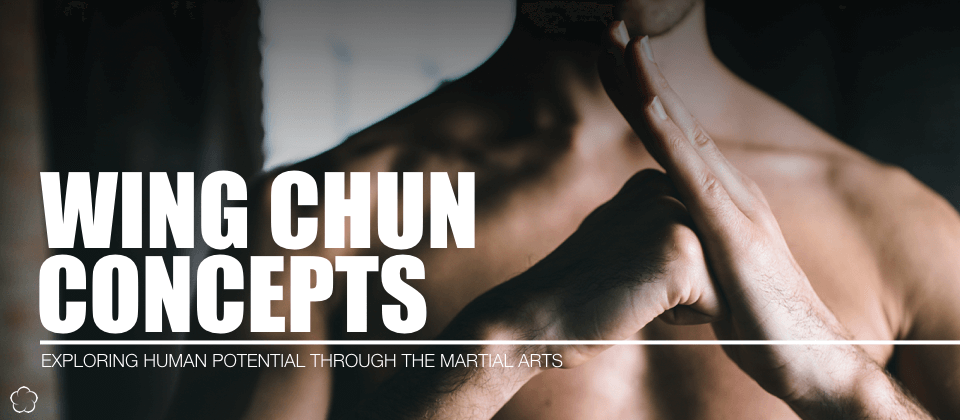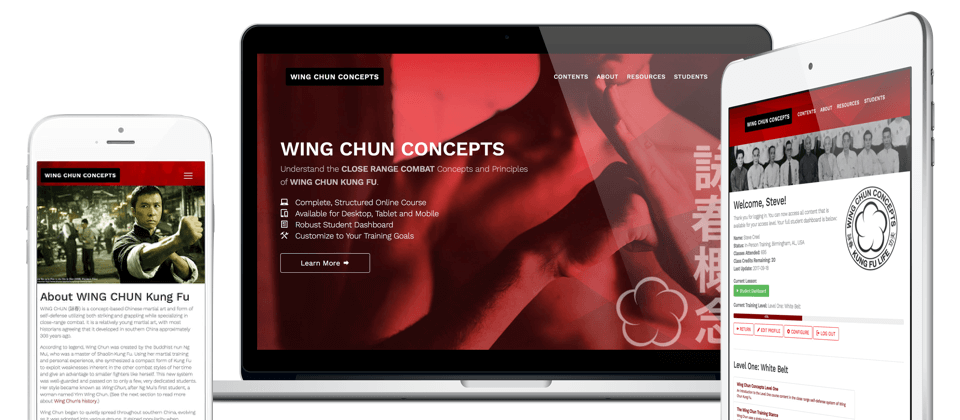
About Wing Chun Concepts
On the first day of training, Sifu Schuyler walked in carrying a large, brown shipping envelope he had brought with him from New York. The package contained our training materials: several typewritten pages that outlined the Wing Chun lineage, core principles and concepts, and a two-page print-out of an Excel document that listed the forms, drills and physical exercises that we would be practicing. The pages had been photocopied again and again, but the information was timeless. This was our Wing Chun curriculum.
As classes grew and evolved, the notes became more detailed. The bullet-lists of forms and drills were updated with concise how-to notes and key points to remember. A paper form was developed with progress bars so students could track their achievements and progress through the system. The "student handbook" grew from a few pages stapled together to a fairly sizable stack in a loose-leaf binder. With the ever-larger number of students, it was a lot of paper to print and maintain.
In what seemed like a smart idea at the time, the notes and curriculum were moved to a simple website, and the Wing Chun Concepts online guidebook was born. Over the last decade, the coursework has continued to evolve, and the underlying technology has evolved with it. Although originally intended only for students attending our local, in-person training, we began to receive emails and phone calls from people around the US and around the world that wanted access. They didn't have access to Wing Chun classes, they explained, or their teacher had no organized curriculum or notes. We listened, and decided to help.
Wing Chun Training: Evolved
The Concepts website now represents a state-of-the-art training experience. Whether you are training in-person at an existing martial arts school, or learning on your own, you'll have access to a complete online curriculum and guidebook with detailed notes and explanations of the forms, drills, techniques, underlying concepts and philosophy of Wing Chun. The current generation of our online training program includes the following features:

ALL ACCESS, ANY DEVICE
You will have full access to the Concepts curriculum from your desktop computer, laptop, tablet or smart phone. You can sign-in from anywhere you have an Internet connection and access your online profile, allowing you to pick up right where you left off.
ROBUST STUDENT DASHBOARD
Students can track their progress at their current level and have one-click access to the current lesson. The dashboard also includes a complete lesson-by-lesson index of every level that you have access to, from the Foundation level through completion of the system.
A FRESH APPROACH
This course represents a very different approach to Wing Chun. It places specific emphasis on Solo Command and Mastery for students who are either training on their own or are optimizing their in-person training with additional independent study. It focuses on practical self-defense in today’s world, with today’s laws, today’s weapons and today’s technology. And this approach is holistic, seeking to transform the body through fitness, the mind through meditation, and the spirit through the timeless wisdom of both East and West.
The format is unique, but the content is built upon the pioneering work of many great Wing Chun instructors. After completing our original training, Sifu Schuyler encouraged us to continue to explore the depths of the Wing Chun system. This led to many years of travel to meet with and train with some of the best and brightest Wing Chun instructors in the world, and we will profile many of these throughout the course.
In particular, Sifu Wayne Belonoha, author of the Wing Chun Compendium books, was a shining example of how to document this training clearly and concisely. Sifu Benny Meng, founder of the Wing Chun Museum, inspired us to dig below the layers of legend and explore the true history and evolution of Wing Chun. The peerless engineer of Wing Chun, Sifu Augustine Fong, revealed not just how Wing Chun works, but why it works. Perhaps most uniquely, renegade pioneer Sifu Francis Fong encouraged us to explore Wing Chun as a living, breathing art, practical in our modern world and complementary to other modern martial arts such as Jiu-Jitsu, Western boxing, Muay Thai, and the Filipino arts of Kali, Escima and Arnis.
At its core, this course is based on the Wing Chun system developed by Grandmaster Ip Man and his senior disciples. The concepts and principles are inspired by the teachings and published work of Grandmaster Moy Yat. This has been enriched by the work of many other pioneering Wing Chun sifus who have contributed to our collective wisdom, including James Yimm Lee, Rene Ritchie, Ip Chun, Ip Ching, Danny Xuan, David Peterson and many, many more. This course only exists because of the tireless work of these Wing Chun giants.
Perhaps most importantly, the Wing Chun Concepts approach has been greatly influenced by the teachings of the late Sifu Bruce Lee, who challenged the entire martial arts world to seek out the essential essence of the Warrior Way. In that spirit, this course hacks away at the non-essential, seeks out the signal in the noise, and focuses entirely on those key concepts that lead directly to meaningful human transformation.
The Concepts Perspective
This guide is called WING CHUN CONCEPTS to emphasize the importance of understanding the underlying concepts, theories and core principles of Wing Chun. Many Kung Fu styles teach movement and application, or technique, alone. The idea is that over time, the student will begin to draw conclusions based on all the techniques they have learned, and this will lead to insight into the underlying principles.
The Concepts course uses the opposite approach. In this course, we will focus on the seed idea or the concept within each movement. This leads you away from traditional, linear thinking – if opponent does "A," then do "B" – and guides you more towards reflexive problem solving. The principle or seed idea can then grow and branch into many different and varied applications.
When applications are shown in this guide, try to keep in mind the underlying principles rather than just the technique itself. For instance, a single move from one of the Wing Chun forms may have multiple applications or techniques that can be drawn from it, but even very different techniques will likely be illustrating a single core principle. This idea will be much less "abstract" as we begin working through the application phase of the curriculum.
Wing Chun Terminology
Modern Wing Chun traces its roots to Hong Kong where the predominant language is Cantonese. Unfortunately, there is no official method of translating written or spoken Cantonese into English, so romanization of terms will vary. For instance, Wing Chun is alternatively spelled as Ving Tsun or Wing Tsun, and the names of individual forms and techniques also have many different spellings. For simplicity, this course will attempt to use the most common spellings in current use.
To make matters worse, we are also going to mix languages. For example, you will see the much more common term Yin and Yang — which is a Mandarin term — rather than the more authentic, but much less well known Cantonese Yum and Yeung terminology. The purists among you are likely going to have a heart attack.
The goal is simply to have a working vocabulary of common terms. Whenever possible we are going to use simple, English names for techniques, concepts and tactics. Although you are neither required nor expected to learn the original Cantonese names, they will nearly always be provided for your reference. Knowing the basic Wing Chun vocabulary will allow you to visit and train with different Wing Chun schools and be comfortable "speaking the same language."
A Paradigm Shift
You may find that the Wing Chun Concepts guide approaches Wing Chun differently than many other published works. Just so there are no surprises, we would like to be clear about three key differences in this approach that may represent a significant paradigm shift from what many people may have experience with.
APPLIED SCIENCE
One difference is that we will fully embrace and explore the science behind the art of Wing Chun. We will draw from the realms of sports medicine, psychology, geometry, physics, anatomy and physiology to offer insights into the Wing Chun concepts.
SELF-DEFENSE EMPHASIS
We will also train Wing Chun as a modern, practical self-defense system. This is going to influence both the type of training we select, as well as the language we use to describe it. For example, most other published works explain techniques in terms of you and your "opponent." This term, and the examples most often shown, is based in the realm of consensual fights or sporting competition. The examples in this guide will be based on violent criminal assault where physical self-defense is morally, ethically and legally justified. The language will shift accordingly, so instead of an "opponent," you will be defending against an "attacker," a "threat" or a "bad guy."
GROWTH and EVOLUTION
Finally, we are viewing Wing Chun as a living, breathing and evolving system, rather than a "written in stone" tradition that must never be changed. As you'll see in the section on Wing Chun History, the concepts of Wing Chun have always grown and evolved as the early masters shared techniques and tactics with masters of other systems of Kung Fu. We will continue that tradition in this guide, both being faithful to the origins and the founding principles of Wing Chun, and comparing, contrasting and learning from other ways of self-defense developed by other cultures.
A Work in Progress
The Wing Chun Concepts course will continue evolving over time, and you are invited to participate in the process. Please join us on Facebook to discuss content, ideas and conclusions. Hopefully we can rise above petty politics and cooperate to allow each of us to further our knowledge and understanding of Wing Chun.
NEXT: About Wing Chun Kung Fu
Wing Chun Kung Fu training is not to be taken lightly. It is not a hobby or leisure activity; it is not a sport or fitness routine. Entering into Wing Chun training is a commitment to the Kung Fu Life. It is a journey of discovery, and a path to unlocking your unique human potential. Begin your journey by learning more about the art and science of Wing Chun Kung Fu.